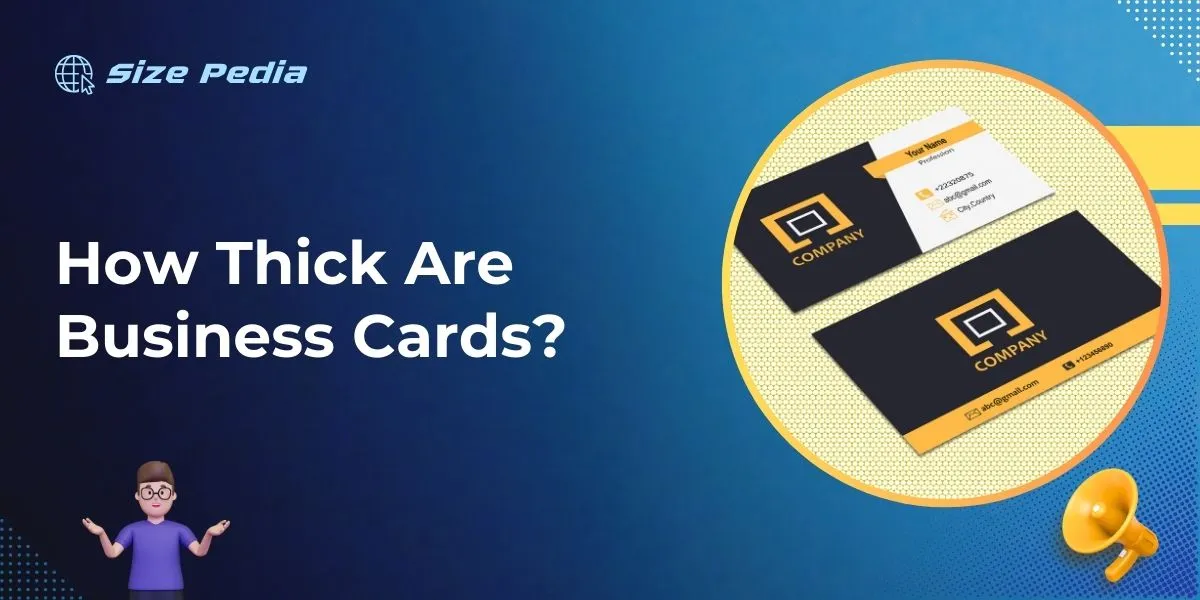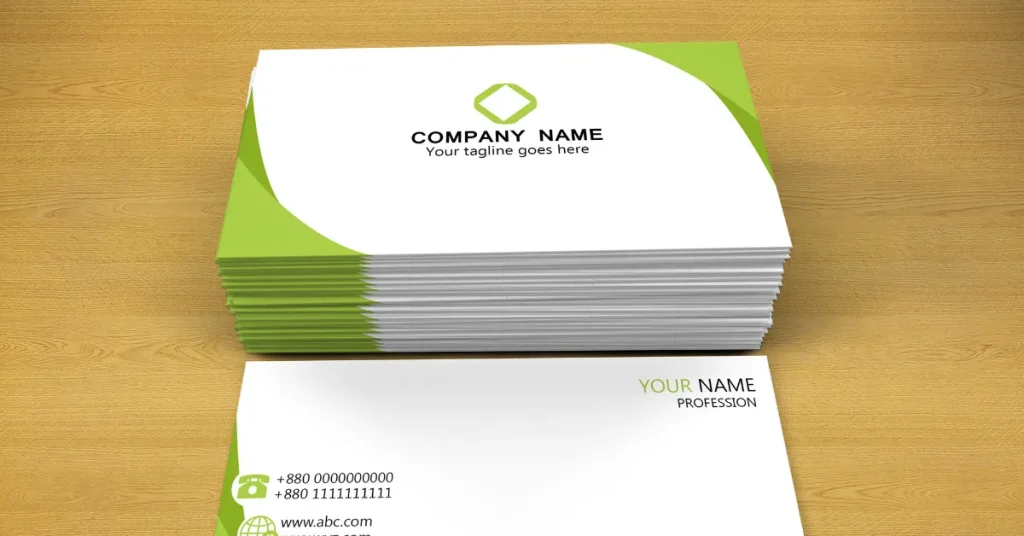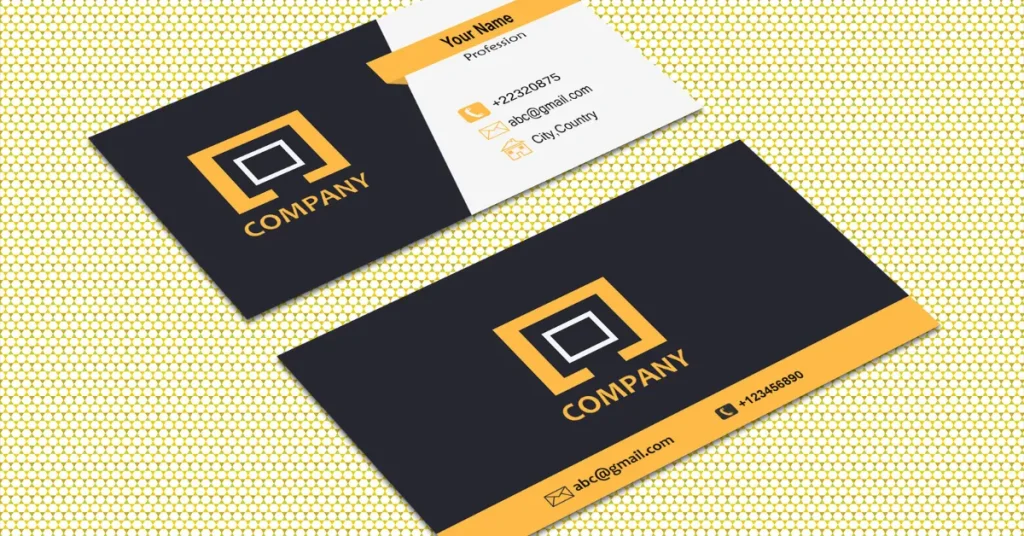Standard business cards are typically 14-16 points (0.014 to 0.016 inches) thick. Some premium cards may be up to 32 points (0.032 inches) thick.
Choosing the right business card thickness is crucial for making a solid first impression. The thickness of a business card can significantly affect its feel, weight, and resilience, which in turn can influence a potential client’s perception of your brand.
Thick business cards often exude a sense of quality and professionalism, reassuring contacts of your commitment to excellence.
Durability is another key factor; a thicker card is less likely to get damaged in a wallet or during handling, ensuring your contact information survives in prime condition.
As businesses strive to stand out in a competitive market, selecting the appropriate card thickness is a subtle yet powerful way to communicate reliability and attention to detail.

The Essence Of Thickness In Business Cards
The thickness of business cards is more than just a measurement; it’s a statement. A card’s heft conveys professionalism and substance, making the first exchange with a potential client memorable.
As we explore the importance of card thickness, we’ll see how it plays a pivotal role in forming perceptions and ensuring the card’s survival through the daily hustle.
Perception Of Quality
The very feel of a thicker business card often leaves a lasting impression. Touch is a powerful sensory channel, and a substantial card signals attention to detail and investment in quality.
It suggests that the individual or company represented by the card holds their brand to high standards. Subliminally, it can set a foundation for trust and professionalism right from the first handshake.
Durability And Longevity
Business cards need to withstand the test of time and repeated handling. A thicker card is less likely to bend, tear, or wear, making it more resistant to the rigors of networking. Here are some key points to consider about durability and longevity:
- Resistance to Damage: Thicker cards are more rigid and can resist being crumpled in a pocket or wallet.
- Preservation of Appearance: A sturdy card maintains its crisp, professional look even after multiple exchanges.
- Extended Lifespan: The likelihood of needing replacement decreases with a more durable card, giving your contact information a longer shelf life.
Standard Measurements
Business cards are a staple in the professional world. Their sizes and thickness set a memorable impression.
They are not one-size-fits-all. A clear understanding of thickness helps in choosing the right card.
Let’s dive into the specifics with standard thickness measurements.
Point System Explained
In the world of paper, thickness gets measured in points. One point (pt) equals 1/1000 of an inch.
This system simplifies comparisons. It helps customers understand card robustness.
Common Thickness Ranges
Thickness can vary based on material and purpose.
- Standard cards: usually between 14 to 20 pt.
- Premium cards: range from 24 to 38 pt.
- Ultra-thick cards: can go up to 32 pt or more.
The final choice impacts both feeling and durability.
Materials Matter
Materials Matter when it comes to the impression your business card makes. The thickness, texture, and overall feel of the card can say a lot about your brand. Let’s explore how different materials influence the heft and look of your business cards.
Paper Types And Weight
The backbone of traditional business cards is paper, but not all paper is the same. Quality varies greatly, affecting the card’s thickness and perception of your brand.
| Paper Type | Weight (lb) | Thickness |
| Standard | 80-110 | Lightweight |
| Premium | 110-130 | Medium |
| Luxury | 130+ | Heavy |
Beyond Paper: Plastic And Metal Cards
For durability and a modern touch, some businesses choose plastic or metal. These materials create a unique tactile experience that stands out.
- Plastic Cards: Flexible yet sturdy, they resist wear and tear.
- Metal Cards: Offer an unmatched premium feel and durability.
Each material option influences the final thickness and can vary from 0.2 to 1 mm for plastic and up to 0.8 mm for metal cards.
Impact Of Thickness On Design

The thickness of business cards adds a tactile dimension to the design. It can influence both the look and feel of your card. As we dive into the impact of thickness on design, it’s clear that this aspect holds significant power.
A thicker card often provides a sense of quality and substance, conveying professionalism. Let’s explore how this choice affects creative potential and design limitations.
Creative Possibilities
A thick business card unlocks various creative opportunities. Designers can use thickness to their advantage, creating features that stand out. Thick cards allow for:
- Debossing or embossing: These techniques offer a 3D effect, giving a high-end feel.
- Edge coloring: Adding a pop of color to the sides makes a bold statement.
- Sandwich cards: Combining layers of paper with different colors enhances design.
These elements can make your business card memorable. A strong visual and tactile impression ensures your brand sticks with potential contacts.
Potential Limitations
While a thicker card boasts benefits, it also presents design challenges. Some considerations include:
- Weight and portability: Thick cards are heavier and may be cumbersome to carry in large quantities.
- Mail-friendly: Extra thickness can lead to higher postage costs for mailing.
- Usability: Some cardholders or wallets might not accommodate extremely thick cards.
Mindful planning can help balance a thick card’s design advantages with these practical limitations, ensuring your card leaves a lasting impression without inconveniencing recipients.
Custom Thickness For Branding
The thickness of your business card can say a lot about your brand. Choosing custom thickness provides an opportunity to stand out in a wallet full of standard cards. It’s about sensory impact and memorability.
Going beyond the typical cardstock can leave a lasting impression on potential clients and partners.
When To Go Thicker Or Thinner
Choosing the right card thickness depends on your brand’s message. A thicker card often portrays luxury, resilience, and stability. On the flip side, a thinner card can convey efficiency and modern minimalism.
Here are scenarios for selecting thickness:
- Thicker cards for high-end services
- Thinner cards for tech-savvy startups
- Mid-range thickness for a balance of tradition and innovation
Case Studies: Memorable Business Cards
Let’s explore how varied thickness shapes brand perception.
| Brand | Industry | Card Thickness | Outcome |
| Luxe Cuisines | Culinary | 32pt | Created a luxurious feel |
| Streamline Tech | Technology | 14pt | Highlighted modern approach |
| GreenScape Design | Landscaping | 18pt | Struck balance: sustainable yet robust |
Each brand used card thickness to enhance their message and identity. Luxe Cuisines opted for a heavy, 32pt card, leaving a feeling of luxury and quality.
Streamline Tech chose 14pt, reinforcing their lean and efficient brand ethos. GreenScape Design went for 18pt. It showcased their commitment to durability and eco-friendliness.
Navigating Cost Versus Value

When deciding on business card thickness, balance is key. Thick cards feel premium and last longer. But, they cost more. Thin cards save money. They might seem less professional. Think about what message you want to send.
Budgeting For Small Businesses
Small businesses must watch every dollar. Yet, a business card is a must-have. It’s a tiny bit of the brand that people take away. Here, choices about material and thickness impact cost directly.
Let’s dive into options:
- Standard cardstock: Around 14-16pt, affordable but professional.
- Premium cardstock: Up to 32pt, double the price, top-notch feel.
- Plastic or metal: Very durable, but could break the bank.
Keep in mind, a balanced approach works best. Pick a decent thickness that doesn’t strain the budget.
Investment In First Impressions
Business cards are part of the first impression. A solid card can speak volumes about your commitment to quality. Investing in a thicker card can pay off in lasting relationships and respect.
| Thickness | Perception | Cost Impact |
| 14-16pt | Professional | Low |
| 18-24pt | High-quality | Medium |
| 32pt+ | Luxurious | High |
Choose wisely. The right card thickness sets the tone. It leaves a lasting impression, showing you mean business.
FAQs About How Thick Are Business Cards
Are Thicker Business Cards Worth It?
Thicker business cards often convey higher quality and professionalism, making a memorable impression; they’re generally considered worth the investment for standing out in networking.
How Thick Are Business Cards In Lbs?
Business card thickness is often measured in points, not pounds (lbs). Standard business cards are typically 14 to 20 points thick, equivalent to roughly. 014 to. 020 inches.
How Thick Are Metal Business Cards?
Metal business cards typically range from 0. 3mm to 0. 5mm in thickness. This robust design ensures durability while maintaining a sleek, professional look.
Is 16pt Cardstock Good For Business Cards?
Yes, 16pt cardstock is excellent for business cards; it offers a sturdy feel and a professional look, appealing to potential clients.
Conclusion
Summing up, business card thickness can greatly impact your professional image. Standard measures rest between 14 to 20 points, with luxe options stretching the scale further.
Choose the thickness that aligns with your brand’s message and leaves a lasting impression.
Remember, the right card can open doors to valuable connections.
Resources:
1. https://www.foamcoreprint.com/blog/best-business-card-stock
